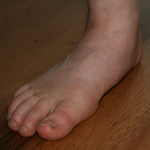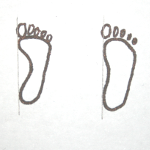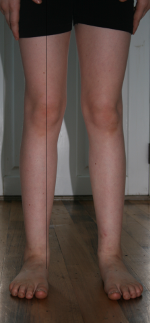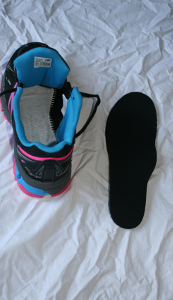Flat feet, known medically as Pes Planus, are commonly seen on examining children and some adults.
Though essentially a normal finding, and generally nothing to be concerned about, they can cause pain on walking or running and it is very common for us to find that children and young adults who complain of sore legs, hips or backs whilst exercising have flat feet. This simple article is intended to help you understand flat feet and to treat yourself. If you have symptoms that do not improve quickly, please see your doctor.
What are flat feet?
Flat feet, simply put, are feet that lack the normal foot arch. The arch usually develops between 4 and 6 years of age and is a consequence of the developing of normal alignment in the feet.
It is thought that arches improve with use - going barefoot seems to be a good thing, especially in the young. Flat feet are known to be more common in children who habitually wear closed-toe shoes as opposed to running barefoot or using sandals. A study of flat feet in India showed up to four times more flat feet in children who wore closed shoes compared with bare feet. There is also a genetic link too, with flat feet running in families.
How are flat feet diagnosed?


Simply looking at the feet is often the best way to tell.
This foot is very flat, with almost no arch at all. A lot of the patient's weight is being borne on the heel and on the base of the big toe and there is almost no space between the floor and the foot.
The 'wet footprint' test can also be used to determine how flat feet are. Standing on card with a damp foot will reveal just how much of an instep is present.
The drawing of footprints on the right shows a normal arch on the left and a flat arch on the right. In the case of the Indian study quoted above, feet were considered flat when there was a gap of less than 1cm between the instep and the pencil-drawn line.
Occasionally, flat feet are caused by problems with the foot joints. These are relatively uncommon. A foot that is still flat when standing on tiptoe is more likely to be a 'rigid' flat foot that may need medical attention.
What problems do flat feet cause?
For most people, the simple answer is none. Flat feet are a normal variant in many people and cause no problems whatsoever.


The key problem, if any is 'overpronation'- the turning in of the ankles so that weight is borne more on the inside of the joint than centrally. This can be seen in the image on the left, where the line on the picture shows the line of weight bearing. As you can see it is quite far off to the inside of the ankle and the knees are turned inwards slightly.
In addition to the incorrect angles and loading of the knee, ankle and hip joints, the overpronation prevents the ankle from being an effective shock-absorber. With a normal arch, the ankle moves properly under pressure but with flat feet, it may already be at or close to its movement limit. Flat feet also change the muscles that are used when walking and affect the function of other joints in the ankle. For those interested in more information, this link is to a scholarly article all about pes planus
In the image to the right, the patient is standing on a pair of arch-supporintg insoles and the overpronation has been corrected significantly. Even though these are medium-high insoles, the overpronation is not fully corrected in this case. A higher insole would be ideal.
So when should flat feet be treated?
This is a matter best discussed with your doctor but in general, we would not worry about a child under 4 at all as flat feet are normal in this age group. After the age of 4, they need treatment only when they are causing symptoms - if the patient has no problems, no treatment is needed. Indeed, there is some evidence that it might be better not to treat though this is not well trialled.
If there is pain, especially after walking or other exercise, then it might be worth trialling a set of arch-supporting insoles. These should be used in sports shoes, shoes used when walking any distance and perhaps school shoes. Symptoms often improve very quickly - a matter of a few weeks if the arch supports are correct. Do see your doctor if symptoms persist.
How to fit an insole:
Using an insole can improve the fit of many shoes, especially for people with flat feet. It may seem odd suggesting fitting an insole that can cost as much as the shoes but the difference it makes can be remarkable. The comfort experienced in a cheap pair of shoes with a quality insole may be greater than that in a much more expensive pair of shoes - or not, as the case may be!
To fit an insole, remove the existing insole from the shoe. This is usually a perfect fit, especially if the shoe is new.
Lay this over the new insole and draw round it. A ballpoint pen is ideal for this.
Simply cut the new insole to fit and insert. Keep the old insoles until you are sure the new ones are better.
This works well on shoes that are reasonably generously sized. Shoes that are tight will often not have enough room for the slightly thicker insole.





This series of images show the process of fitting an insole - note that it is not generally necessary to trim the insole sides.
The Arch range has a good selection of sizes and styles of insole, though are very expensive - the cost was half that of the New Balance training shoe. The quality is exceptional however and they are very easy to trim and fit.
It is wise to buy the insole at the same time as you buy the shoe, and from the same store. This way, you may be protected by the Consumer Guarantees Act if the insole is not suitable for the shoe for which it was sold. Most insoles will suit only a small range of sizes and it is important to check whether the shoe and insole are sized on the same system.